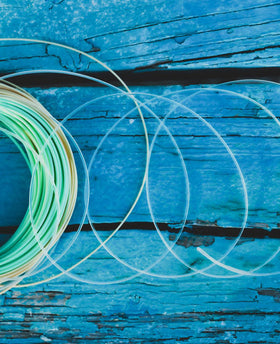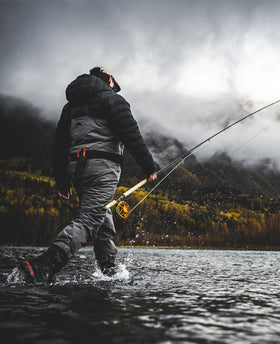
Overcoming the Challenges of the Blue River
The Blue River through Silverthorne is one of the most challenging rivers in the entire state. Although often gin clear, it can be difficult finding where the fish are sitting. Even then if you find them, it’s quite difficult figuring out what they want to eat. Oftentimes it’s such a struggle that we’ll see people fishing the smallest bugs in their box, even down to a size 28. It’s a headache, but when you see a 2 foot rainbow trout sitting right in front of you, you’ll do just about anything to get it to eat. Looking beyond its difficulty, the Blue is one of the best fisheries within two hours of the Denver area. The river holds large rainbow and brown trout, and, during the fall, kokanee salmon. It’s a very technical river that is very challenging but if approached correctly can yield very large fish and even make you a better angler. But why aren’t most people catching fish on the Blue? Well let’s break it down.

#1: Fishing Dead Water
Yes, there’s a lot of water on the Blue that doesn’t hold any fish even when it looks incredibly fishy looking. It can be so frustrating fishing a run for a decent amount of time and never realizing there weren’t any fish in it. To avoid wasting your time and increase your chances of actually getting into a fish you need to fish where fish are at. Well yeah, no duh. What I mean by this is you need to spend all of your time sight fishing on the Blue. If you aren’t sight fishing there’s no guarantee there’s even a fish there. Spotting fish on the Blue can be difficult even though its water is incredibly clear, the bottom of the river is composed predominantly of small boulders that vary in colors and allow for fish to easily blend in. To make matters worse, a lot of fish adapt quickly to their environment and develop a lighter, silvery hue. So how the heck do we even find a fish? There’s many ways to approach sight fishing, but without writing an entire essay on this I’ll keep it brief. The number one tactic I use to spot fish on the Blue is looking for a subtle red stripe in the water. A big mistake a lot of people make is looking for an entire fish, and a lot of the time this just isn’t possible. But if you can spot a faint red stripe in the water that’s likely a fish. Remember these fish have a very light hue that makes them blend in, but a lot of the time that red stripe never goes away! This isn’t always going to hold up and oftentimes I’ll have to deploy different tactics as the day goes on, but for the most part this gets me by. Once you begin to get comfortable with spotting and catching fish on the Blue, I promise you’ll become a better fisherman. There are very few waters where sight fishing is as difficult as it is on the Blue.
#2: Using the Wrong Flies
You can say this for just about any water in the world, if you fish the wrong flies you won’t catch fish. I don’t necessarily believe this, fish are a lot dumber than we give them credit for. The majority of flies will catch fish anywhere at any time, if you fish them right. But I digress. There’s a lot of times where I see people fishing the wrong fly, for the Blue. This point is twofold. A ton of people fish mysis shrimp on the Blue which would seem like a good fly for the Blue judging that there’s a ton of mysis in Dillon Reservoir. The issue here is that the flows coming out of the reservoir remain relatively stable throughout the year leading to very little mysis “flushing events” that is seen on the Frying Pan and Taylor. Surprisingly enough, there are more mysis shrimp flushed out of Robert’s Tunnel into the North Fork of the South Platte because the tunnel sees huge ranges in flows that can flush these mysis into the river. My point is, stop fishing the mysis on the Blue. There’s a few scenarios in high water and/or night that it can work, but most of the time you’re using a fly that’s resembling absolutely nothing those fish have seen before, or at least seen regularly enough to be a food source.

Furthermore, the majority of people are using too small of flies in my mind. I know a ton of people that use size 24’s and smaller and have relatively decent luck. I’ve noticed that if I’m actively fishing for one fish, I can get away with flies that are bigger than that. A lot of the time I’m using flies that range from 12’s to 22’s. This could be shocking to many of you, but trust me, I almost never use tiny flies on the Blue. My favorite flies on the Blue are size 12 san juan worms, size 18 midge larva, size 22 darth baetis, size 16 zebra midges, and size 18-22 RS2s. I always have a large variety of flies with me, but these are my day-to-day go to flies. Yes, the fish in the Blue will eat smaller flies, but I’ve found there’s very few times where they’ll refuse a fly in that size range as long as it isn’t too bright or flashy. Additionally, using those bigger flies will lead to higher landing rate which seems to be an issue on this river.
#3: That Darn Indicator
Most of the time your indicator color doesn’t matter, but there’s some rivers that will prove that wrong very quickly. We’ve personally noticed that if you aren’t fishing a drab yarn or clear indicator on waters like the San Juan, Taylor, and Frying Pan you flat out aren’t catching fish. The same can be said for the Blue. These fish get hit hard and the water is gin clear, so after seeing enough colored balloons (yes, even white) float over their head they get wary of what’s going on.

The nice thing about a drab colored yarn indicator is that it can blend in with the bubbles or debris floating on the water, with the added benefit of picking up eats faster. The downside to yarn indicators is that you’ll need to keep up with them all day so they continue to float and they also do not cast well in windy conditions.

A clear indicator is an excellent way to approach this scenario because it can still support a lot more weight than yarn and it’s virtually invisible to the fish. The only downside is the only company that produces them now is Thingamabobber, which is well known for kinking leaders. Both indicators have pros and cons, but whichever you choose it’ll be a much better option than a standard colored indicator.

The Blue River through the town of Silverthorne is a very difficult stretch of water, but with these three tips it should make things a lot easier. Take your time while fishing the water, make sure you’re actively fishing to a fish, focus on your drift, and the rest will fall into place. We hope these tips helped you out and best of luck on the Blue! If you have any questions about fishing the Blue, feel free to reach out to Xavier via email at xavier@goldenflyshop.com, or call the shop at 303-330-1292.




Comments
Leave a comment